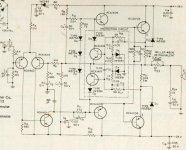hello, can anyone explain me how you can calculate the value of R4 in the included schematic, it's depending on the input resistance of the transistor and the current through the diff amp, anyway I tried to calculate it but always I came out on values about ten times higher than the right one.
thanks,
HB.
thanks,
HB.
Attachments
Hugo,
Resistor R4 is depending on the current in diff pair, at first time you can ignore the input impedance of the transistor, which is high.
Current in diff pair is about 2 mA, and must be equal in each transistor. So, current in R4 is 1mA. Vbe of the transistor is about 0.6 V , and R4 is 600 Ohms.
A slightly higher value is correct : because of the base current of the transistor, the current across R4 is slightly less than 1 mA in fact.
Regards, P.Lacombe.
Resistor R4 is depending on the current in diff pair, at first time you can ignore the input impedance of the transistor, which is high.
Current in diff pair is about 2 mA, and must be equal in each transistor. So, current in R4 is 1mA. Vbe of the transistor is about 0.6 V , and R4 is 600 Ohms.
A slightly higher value is correct : because of the base current of the transistor, the current across R4 is slightly less than 1 mA in fact.
Regards, P.Lacombe.
So, if I understand it well:
the voltage over R4 is 0.6V and we know the current of the diff.amp so we can calculate the value of R4 (we choose a little higher value which makes some current through the base).
but how about the current through the biasing-circuit (here 3 diodes) then, is that limited by R8 + R10 + R10A + R11??
So this is what I thought by so far (before this thread):
the voltage over R8 + R10 must be half the total supply voltage (like in class A) in is adjusted by the current through the base RCA1A01.
So this in fact correct, but the feedback network will take care of that, right? So we don't have to set up that base current manually (with exact resistors).
thanks,
HB.
the voltage over R4 is 0.6V and we know the current of the diff.amp so we can calculate the value of R4 (we choose a little higher value which makes some current through the base).
but how about the current through the biasing-circuit (here 3 diodes) then, is that limited by R8 + R10 + R10A + R11??
So this is what I thought by so far (before this thread):
the voltage over R8 + R10 must be half the total supply voltage (like in class A) in is adjusted by the current through the base RCA1A01.
So this in fact correct, but the feedback network will take care of that, right? So we don't have to set up that base current manually (with exact resistors).
thanks,
HB.
Hugo,
Yes, you are right. Because of C5, feedback factor is 100% for DC. So, if the DC voltage at the output is not zero, feedback will alterate the balance of the differential stage, modifying the base current of RCA1A01. It is a good idea to make R4 slighly variable, in order to tune the output DC voltage at exact zero when the amplifier is at working temperature, and no signal at the input. But in fact this not necessary because loudspeakers can tolerate little offset voltage.
Regards, P.Lacombe.
Yes, you are right. Because of C5, feedback factor is 100% for DC. So, if the DC voltage at the output is not zero, feedback will alterate the balance of the differential stage, modifying the base current of RCA1A01. It is a good idea to make R4 slighly variable, in order to tune the output DC voltage at exact zero when the amplifier is at working temperature, and no signal at the input. But in fact this not necessary because loudspeakers can tolerate little offset voltage.
Regards, P.Lacombe.
- Status
- Not open for further replies.
